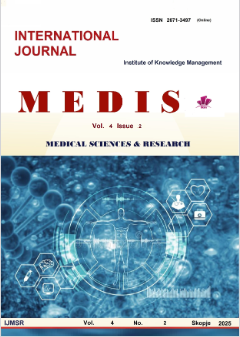PERSPECTIVES ON OPEN WEDGE HIGH TIBIAL OSTEOTOMY IN EARLY-STAGE GONARTHROSIS: A FOCUSED LITERATURE REVIEW
DOI:
https://doi.org/10.35120/medisij040231vKeywords:
OWHTO, gonarthrosis, high tibial osteotomy, knee osteoarthritis, joint preservation, fixation technique, realignment surgery, varus deformityAbstract
Open Wedge High Tibial Osteotomy (OWHTO) has gained clinical momentum as a joint-preserving surgical technique for managing early to moderate medial compartment gonarthrosis, especially in younger, active patients with varus deformity. In contrast to total knee arthroplasty (TKA), OWHTO preserves native joint anatomy and function, offering a biomechanically sound alternative with the potential to delay or avoid prosthetic intervention. The objective of this literature review was to evaluate the current state of evidence regarding OWHTO, with particular emphasis on patient selection criteria, surgical planning and fixation techniques, clinical outcomes, complication profiles, and long-term survivorship. This review also aims to identify limitations in the existing body of literature and propose areas for future research. A focused literature review was conducted using PubMed, Google Scholar, and ScienceDirect databases. Studies published between January 2015 and March 2025 were screened using keywords such as “open wedge high tibial osteotomy,” “OWHTO,” “gonarthrosis,” “medial compartment osteoarthritis,” and “joint preservation.” A total of eleven studies met the inclusion criteria, consisting of systematic reviews, meta-analyses, retrospective cohort studies, randomized controlled trials, and long-term case series. Data were extracted on surgical technique, fixation methods, outcome measures, follow-up duration, and reported limitations. The reviewed literature demonstrates that OWHTO offers consistent improvements in functional outcomes, including KOOS, WOMAC, IKDC, OKS, HSS, and SF-12 scores. Long-term survivorship reached up to 91.5% at 13.6 years in selected patients. Common surgical tools included TomoFix and Puddu plates, with fixation technique often influencing union rate and complication frequency. However, substantial heterogeneity exists across studies in terms of surgical reporting, fixation types, and patient demographics. Overcorrection beyond mechanical axis alignment targets was associated with increased complication rates without proportional functional gain. Most studies lacked detail on mean age, BMI, comorbidities, and rehabilitation protocols, limiting the generalizability of outcomes. OWHTO remains a clinically effective and biomechanically advantageous intervention for early-stage medial knee osteoarthritis in appropriately selected patients. The technique is associated with durable mid- to long-term outcomes, reduced pain, and improved functional capacity, with the added benefit of postponing or avoiding total knee arthroplasty.: Future research should prioritize standardized reporting of surgical techniques, fixation systems, and patient stratification. High-quality, multicenter prospective trials are needed to develop uniform treatment algorithms and better identify predictive factors for successful outcomes. Inclusion of long-term patient-reported outcomes and complication profiles will be essential for guiding surgical decision-making and health policy integration. This review included three systematic/meta-analyses and eight original studies encompassing over 6,500 cases. Follow-up durations ranged from 5 to 13.6 years. Despite methodological differences, the consensus across studies supports OWHTO as a valuable alternative in the spectrum of knee-preserving interventions.
Downloads
References
Bei, T., Yang, L., Huang, Q., Wu, J., & Liu, J. (2022). Effectiveness of bone substitute materials in opening wedge high tibial osteotomy: a systematic review and meta-analysis. Annals of Medicine, 54(1), 565–577. https://doi.org/10.1080/07853890.2022.2036805
Gkekas, N. K., Komnos, G. A., Mylonas, T., Chalatsis, G., Koutalos, A. A., & Hantes, M. E. (2025). Medial open wedge high tibial osteotomy is a viable option in young patients with advanced arthritis in a long-term follow-up. Knee surgery, sports traumatology, arthroscopy : official journal of the ESSKA, 33(3), 1025–1032. https://doi.org/10.1002/ksa.12469
Han, J. H., Yang, J. H., Bhandare, N. N., Suh, D. W., Lee, J. S., Chang, Y. S., Yeom, J. W., & Nha, K. W. (2016). Total knee arthroplasty after failed high tibial osteotomy: a systematic review of open versus closed wedge osteotomy. Knee surgery, sports traumatology, arthroscopy : official journal of the ESSKA, 24(8), 2567–2577. https://doi.org/10.1007/s00167-015-3807-1
He, M., Zhong, X., Li, Z., Shen, K., & Zeng, W. (2021). Progress in the treatment of knee osteoarthritis with high tibial osteotomy: a systematic review. Systematic reviews, 10(1), 56. https://doi.org/10.1186/s13643-021-01601-z
Kim, J. H., Kim, H. J., & Lee, D. H. (2017). Survival of opening versus closing wedge high tibial osteotomy: A meta-analysis. Scientific Reports, 7, Article 7296. https://doi.org/10.1038/s41598-017-07856-8
Kim, J. I., Kim, B. H., Lee, K. W., Lee, O., Han, H. S., Lee, S., & Lee, M. C. (2016). Lower Limb Length Discrepancy After High Tibial Osteotomy: Prospective Randomized Controlled Trial of Lateral Closing Versus Medial Opening Wedge Osteotomy. The American journal of sports medicine, 44(12), 3095–3102. https://doi.org/10.1177/0363546516659284
Kim, K. I., Kim, J. H., Lee, S. H., Song, S. J., & Jo, M. G. (2022). Mid- to Long-Term Outcomes After Medial Open-Wedge High Tibial Osteotomy in Patients With Radiological Kissing Lesion. Orthopaedic journal of sports medicine, 10(7), 23259671221101875. https://doi.org/10.1177/23259671221101875
Pipino, G., Indelli, P. F., Tigani, D., Maffei, G., & Vaccarisi, D. (2016). Opening-wedge high tibial osteotomy: a seven - to twelve-year study. Joints, 4(1), 6–11. https://doi.org/10.11138/jts/2016.4.1.006
Porcelli, G., et al. (2024). Medial opening wedge high tibial osteotomy using the Puddu plate: A retrospective study. Revista de la Asociación Argentina de Ortopedia y Traumatología, 89(2), 67–73. https://doi.org/10.15417/issn.1852-7434.2024.89.5.1475
Wang, Y., Chen, L., Zhang, W., Lin, X., & Wang, Y. (2018). Is opening-wedge high tibial osteotomy superior to closing-wedge high tibial osteotomy in treatment of unicompartmental osteoarthritis? A meta-analysis of randomized controlled trials. Journal of Orthopaedic Surgery and Research, 13(1), 1–8. https://doi.org/10.1016/j.ijsu.2018.10.045
Xu, K., Wang, T., Yu, T., Zhao, X., Zhang, Y., & Zhang, L. (2024). Comparison of different degrees of varus deformity correction with open-wedge high tibial osteotomy: a retrospective study over 5 years. Journal of orthopaedic surgery and research, 19(1), 93. https://doi.org/10.1186/s13018-024-04557-7
Downloads
Published
Issue
Section
License

This work is licensed under a Creative Commons Attribution-NonCommercial 4.0 International License.






